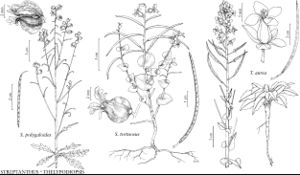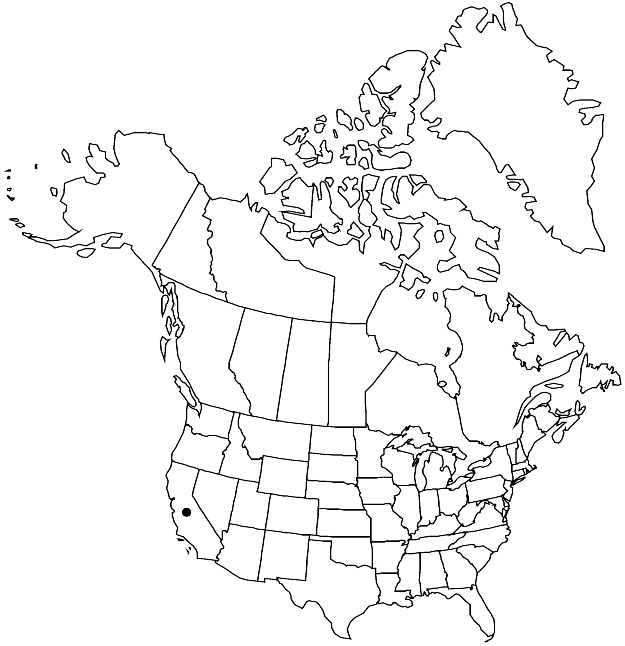Difference between revisions of "Streptanthus polygaloides"
Proc. Amer. Acad. Arts 6: 519. 1865.
FNA>Volume Importer |
imported>Volume Importer |
||
| (5 intermediate revisions by 2 users not shown) | |||
| Line 6: | Line 6: | ||
|place=6: 519. 1865 | |place=6: 519. 1865 | ||
|year=1865 | |year=1865 | ||
| + | }} | ||
| + | |special_status={{Treatment/ID/Special_status | ||
| + | |code=F | ||
| + | |label=Illustrated | ||
| + | }}{{Treatment/ID/Special_status | ||
| + | |code=E | ||
| + | |label=Endemic | ||
}} | }} | ||
|basionyms= | |basionyms= | ||
| Line 11: | Line 18: | ||
|name=Microsemia polygaloides | |name=Microsemia polygaloides | ||
|authority=(A. Gray) Greene | |authority=(A. Gray) Greene | ||
| + | |rank=species | ||
}} | }} | ||
|hierarchy=Brassicaceae;Brassicaceae tribe Thelypodieae;Streptanthus;Streptanthus polygaloides | |hierarchy=Brassicaceae;Brassicaceae tribe Thelypodieae;Streptanthus;Streptanthus polygaloides | ||
| Line 36: | Line 44: | ||
-->{{#Taxon: | -->{{#Taxon: | ||
name=Streptanthus polygaloides | name=Streptanthus polygaloides | ||
| − | |||
|authority=A. Gray | |authority=A. Gray | ||
|rank=species | |rank=species | ||
| Line 50: | Line 57: | ||
|publication title=Proc. Amer. Acad. Arts | |publication title=Proc. Amer. Acad. Arts | ||
|publication year=1865 | |publication year=1865 | ||
| − | |special status= | + | |special status=Illustrated;Endemic |
| − | |source xml=https:// | + | |source xml=https://bitbucket.org/aafc-mbb/fna-data-curation/src/2e0870ddd59836b60bcf96646a41e87ea5a5943a/coarse_grained_fna_xml/V7/V7_1255.xml |
|tribe=Brassicaceae tribe Thelypodieae | |tribe=Brassicaceae tribe Thelypodieae | ||
|genus=Streptanthus | |genus=Streptanthus | ||
Latest revision as of 22:31, 5 November 2020
Annuals; (sometimes glaucous), glabrous throughout. Stems unbranched or branched distally, (0.8–)2–8(–10) dm. Basal leaves (soon withered); rosulate; petiolate; blade 1- or 2-pinnatifid (with broadly linear to filiform lobes), 2–20 cm, margins sinuate-dentate. Cauline leaves: blade linear, 1–10 cm × 1–3 mm, (smaller distally), base auriculate, margins entire. Racemes ebracteate, (lax). Fruiting pedicels strongly recurved, 2–5 mm. Flowers (markedly zygomorphic); calyx urceolate; sepals greenish yellow or purplish, (abaxial broadly ovate, not keeled, 4–6 × 3–4 mm, lateral ovate-lanceolate, keeled, 4–6 × 1.5–2 mm, adaxial suborbicular to broadly ovate-cordate, forming a bannerlike hood, keeled, 4–6 × 6–8 mm); petals white (with brownish veins), 5–8 mm, blade 1–3 × 0.7–1.2 mm, margins crisped (channeled), claw 4–5 mm, wider than blade; stamens in 3 unequal pairs; filaments: abaxial pair (distinct), 4–5 mm, lateral pair 3–4 mm, adaxial pair (connate), 5–6 mm; anthers: abaxial and lateral pairs fertile, 1.5–2 mm, adaxial pairs sterile, 0.3–0.7 mm; gynophore 0.1–0.4 mm. Fruits pendent, smooth, straight, flattened, 2.4–5.6 cm × 1.2–1.7 mm; valves each with obscure or somewhat prominent midvein; replum straight; ovules (10–)18–50 per ovary; style 0.8–2 mm; stigma entire. Seeds oblong, 1.7–2 × 0.9–1.1 mm; wing 0.2–0.3 mm wide, distal. 2n = 28.
Phenology: Flowering May–Jul.
Habitat: Serpentine substrates in grasslands, openings chaparral, oak and pine woodlands
Elevation: 200-1900 m
Discussion
Streptanthus polygaloides is highly variable in plant height, flower color, fruit size, and dissection of basal leaves. Further studies may lead to recognition of infraspecific taxa. The species is distributed in Butte, Calaveras, El Dorado, Fresno, Mariposa, Nevada, Sierra, Tuolumne, and Yuba counties.
Streptanthus polygaloides is one of the few nickel hyperaccumulators in the flora area, and it averages 2,430–18,600 µg/g dry weight (R. D. Reeves et al. 1981; A. R. Kruckeberg and Reeves 1995).
Selected References
None.

